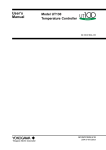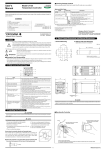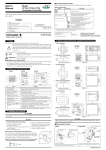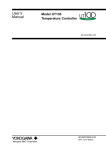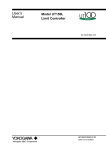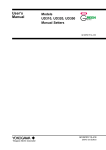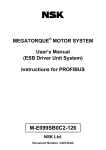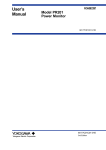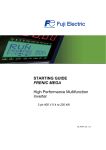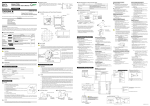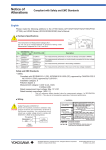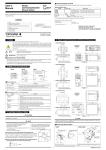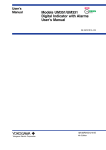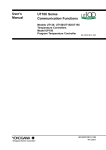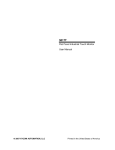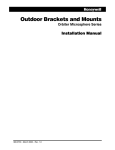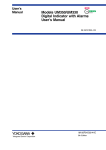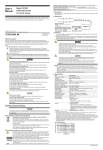Download User`s Manual
Transcript
User’s
Manual
Models
UT150, UT152, UT155
Temperature Controllers
IM 05C01E12-41E
IM 05C01E12-41E
2004.6 4th Edition
Note: This user’s manual (IM 05C01E12-41E) is a re-edited, A4-size
version of the IM 05C01E12-01E user’s manual that is supplied
along with the product shipped. Therefore, both manuals have the
same contents, except for some minor differences in the crossreferenced page numbers.
Revision Record
●Manual No. : IM 05C01E12-41E(4th Edition)
●Title
: Models UT150,UT152,UT155 Temperature Controllers
Edition
First
Date
Nov.,2000
Second
Revised Item
Newly published
Mar.,2001
Correct
Third
Sep.,2003
Correct
Fourth
Jun.,2004
Change of the company name.
Please read through this user’s manual to ensure correct usage of the controller and keep it handy for quick
reference.
CONTENTS
1. Notice ............................................................................................................................... 2
2. What is on the Front Panel? ......................................................................................... 3
3. Installing the Controller ................................................................................................ 4
4. Panel Cutout Dimensions and External Dimensions .................................................. 5
5. Wiring .............................................................................................................................. 6
6. Hardware Specifications ................................................................................................ 9
7. Key Operations ............................................................................................................. 11
8. Troubleshooting ............................................................................................................ 20
■ Checking Package Contents
Before using the product, check that its model & suffix codes are as you ordered.
Model and Suffix Codes
Model
Suffix code
UT150
UT152
UT155
Control output for standard
type (or for heating)
Control output for cooling
Description
Temperature controller
–R
–V
–A
Relay output (time-proportional PID or on/off control)
Voltage pulse output (time-proportional PID)
4 to 20mA output (continuous PID)
N
R
V
A
No cooling output (standard type)
Relay output (time-proportional PID or on/off control)
Voltage pulse output (time-proportional PID)
4 to 20mA output (continuous PID)
/AL
/HBA
/EX
Option
/RET
/RS
/V24
Alarm outputs (2 points)
Heater disconnection alarm (includes optional /AL function)
SP1/SP2 switching, starting of timer, and RUN/STOP
switching by external contacts
PV retransmission output in 4 to 20mA
Communication function
Power Supply 24V DC / 24V AC
Note:When specifying the /RS option, be sure to order the required number of copies of
Communication Functions User’s Manual separately.
Check the package contents against the list below.
• Temperature controller .......................... 1
• Mounting bracket ................................ 1 for UT150
2 for UT152, UT155
• User’s manual (IM 05C01E12-01E) .......... 1
IM 05C01E12-41E
1
1.
NOTICE
The following safety symbol is used both on the product and in this user’s manual.
This symbol stands for “Handle with Care.” When displayed on the product, the operator should
refer to the corresponding explanation given in the user’s manual in order to avoid injury or death of
personnel and/or damage to the product. In the manual the symbol is accompanied by an explanation
of the special care that is required to avoid shock or other dangers that may result in injury or loss of
life.
The following symbols are used in this manual only.
NOTE
Indicates that operating the hardware or software in a particular manner may lead to damage or result in
system failure.
IMPORTANT
Draws attention to information that is essential for understanding the operation and/or features of the
product.
■ Exemption from Responsibility
Make sure that all of the precautions are strictly adhered to. Yokogawa Electric Corporation assumes no
liability for any damage resulting from use of the instrument in contradiction to the precautions.Also,
Yokogawa Electric Corporation assumes no liability to any party for any loss or damage, direct or indirect,
caused by the use or any unpredictable defect of the instrument.
2
IM 05C01E12-41E
2.
WHAT IS ON THE FRONT PANEL?
UT150
UT152
UT155
a.
e.
e.
d.
a.
b.
g.
c.
c.
a.
b.
f.
e.
c.
f.
d.
d.
b.
f.
h.
h.
g.
h.
g.
Name
Function
a.
PV display (red)
Indicates PV (measured value) and character information such as parameter codes and error codes.
b.
SP display (green)
Indicates SP (target setpoint) and parameter values.
c.
Alarm 1 (AL1) lamp (red)
Lit when alarm 1 is activated.
d.
Alarm 2 (AL2) lamp (red)
Lit when alarm 2 is activated.
e.
SP2 lamp (green)
Lit when SP2 is being used for control operation.
f.
Output (OUT) display lamps
UT150: (Left: orange; right: green)
UT152, UT155:
(Upper: orange; lower: green)
Lit while control output is being output.
• The left (upper) lamp is lit in orange during control output of standard type.
• In heating/cooling control, the left (upper) lamp lights up in orange when the heating-side output
is active; while the right (lower) lamp lights up in green when the cooling-side output is active.
g.
Data change keys
(Indicated as simply the
keys hereafter.)
• Changes SP and the parameter values.
• Pressing the
key decreases the data value and pressing the
key increases
it. Holding down the key will gradually increase the speed of the change.
h.
and
SET/ENT key (data registering key)
(Indicated as simply the
key
hereafter.)
IM 05C01E12-41E
• Registers the data value changed using the data change keys.
• Switches between operating displays or parameter setting displays sequentially.
• Pressing the key for 3 seconds or longer in the operating display retrieves the
operating parameter setting display.
• Pressing the key for 3 seconds or longer in either an operating or setup parameter
setting display transfers back to operating display 1. (See Page 13.)
3
3.
INSTALLING THE CONTROLLER
CAUTION
To prevent electric shock, the source of power to the controller must be turned off when mounting the
controller on to a panel.
NOTE
To install the controller, select a location where:
1. No-one may accidentally touch the terminals;
2. Mechanical vibrations are minimal;
3. Corrosive gas is minimal;
4. The temperature can be maintained at about 23°C
with minimal fluctuation;
5. There is no direct heat radiation;
6. There are no resulting magnetic disturbances;
7. The terminal board (reference junction compensation element, etc.) is protected from wind;
8. There is no splashing of water; and
9. There are no flammable materials.
Never place the controller directly on flammable items.
If the controller has to be installed close to flammable items or equipment, be
sure to enclose the controller in shielding panels positioned at least 150mm away
from each side. These panels should be made of either 1.43mm thick metalplated steel plates or 1.6mm thick uncoated steel plates.
●Mount the controller at an angle within 30° from horizontal with
the screen facing upward. Do not mount it facing downward.
150mm
150mm
150mm
150mm
30° (MAX)
■ Mounting the Controller
UT150
Large bracket
(top)
UT152, UT155
Panel
1. Affix the bracket over the back
end of the controller.
2. Push the bracket to the panel,
and then secure the bracket
into position.
Terminal board
Panel
Direction for mounting
Insert a screwdriver
into the brackets to
tighten the screws .
UT150
Bracket
[ How to remove the bracket]
To move the bracket, push down the center of the upper and lower
parts of the controller softly.
The bracket is released from the latch.
4
Small bracket
(bottom)
Insert the controller into the opening with the terminal board facing the front.
Set and tighten the top and bottom brackets on the controller to fix it on the
IM 05C01E12-41E
4.
PANEL CUTOUT DIMENSIONS AND
EXTERNAL DIMENSIONS
NOTE
Splash-proof construction is not available when the side-by-side close mounting method shown in the
following figures, is chosen for any of the controllers.
1. General Mounting
max. 44.8
Unit: mm
45 +0.6
0
25
45 +0.6
0
48
12
100
45 +0.6
0
48
max. 44.8
2. Side-by-side Close Mounting
[(N –1) × 48 + 45] +0.6
0
N is the number of controllers.
If N > 5, then measure the actual length.
max. 61
min. 70
25
UT150
max. 47.8
min. 70
Panel thickness
1 to 10
1. General Mounting
UT152
53
min. 145
Unit: mm
11
100
max. 91.8
45 +0.6
0
96
25
92 +0.8
0
2. Side-by-side Close Mounting
[(N –1) × 48 + 45] +0.6
0
max. 112
92 +0.8
0
48
max. 44.6
1-1021-301-20
min. 70
Panel thickness
1 to 10
N is the number of controllers.
If N > 5, then measure the actual length.
min. 117
UT155
92 +0 0.8
53
min. 145
Unit: mm
100
92 +0.8
0
2. Side-by-side Close Mounting
[(N –1) × 96 + 92] +0.8
0
max. 112
+ 0.8
0
max. 91.8
92
96
25
11
96
max. 91.8
1-1051-6041-5031-4021-3011-20
1. General Mounting
N is the number of controllers.
If N > 5, then measure the actual length.
IM 05C01E12-41E
Panel thickness
1 to 10
5
5.
WIRING
CAUTION
1) Before you start wiring, turn off the power source and use a tester to check that the controller and cables
are not receiving any power in order to prevent electric shock.
2) For safety, be sure to install a circuit breaker switch (of 5A and 100V AC or 220V AC, and that
conforms to IEC60947) near the instrument so as to be operated easily, and clearly indicate that the
device is used to de-energize the instrument.
3) Wiring should be carried out by personnel with appropriate electrical knowledge and experience.
IMPORTANT
1) Use a single-phase power source. If the source has a lot of noise, use an isolation transformer for the
primary side and a line filter (we recommend TDK’s ZAC2205-00U product) for the secondary side.
When this noise-prevention measure is taken, keep the primary and secondary power cables well apart.
Since the controller has no fuse, be sure to install a circuit breaker switch (of 5A and 100V AC or 220V
AC, and that conforms to IEC standards) and clearly indicate that the device is used to de-energize the
controller.
2) For thermocouple input, use shielded compensating lead wires. For RTD input, use shielded wires which
have low resistance and no resistance difference between the 3 wires. See the table given later for the
specifications of the cables and terminals and the recommended products.
3) The control output relay cannot be replaced even though it has a limited service life (100,000 relay
contacts for the resistance load). Thus, an auxiliary relay should be used so that the load can be turned
on and off.
4) When using an inductive load (L) such as an auxiliary relay and solenoid valve, be sure to insert a CR
filter (for AC) or diode (for DC) in parallel as a spark-rejecting surge suppressor to prevent malfunctions
or damage to the relay.
5) When there is the possibility of being struck by external lightening surge, use the arrester to protect the
instrument.
NOTE
• Always fix a terminal cover bracket to the UT150 controller before wiring if an optional anti-electricshock terminal cover (part number: L4000FB) is used.
• Two types of optional anti-electric-shock terminal covers (part numbers T9115YE and T9115YD) are
available for the UT152 and UT155 controllers, respectively.
● Cable Specifications and Recommended Products
Power supply and relay contact output 600V vinyl insulated wire/cable, JIS C3307, 0.9 to 2.0mm2
Thermocouple input
Shielded compensating lead wire, JIS C1610
RTD input
Shielded wire (3-wire), UL2482 (Hitachi cable)
Other signals
Shielded wire
● Recommended Terminals
Use M3.5 screw-compatible crimp-on terminals with an insulating sleeve, as shown below.
ø 3.7mm
7mm or less
6
7mm or less
ø 3.7mm
IM 05C01E12-41E
■ UT150 Terminal Arrangement (Standard type)
Retransmission Output
Heater Current Detection Input
+
1
Alarm Outputs
1
CT
2
–
2
When “/HBA”
is specified.
ALM1
13
COM
TC Input
RS-485
3 RSB(+)
RSA(–)
8
When “/AL” or “/HBA”
is specified.
1
4
ALM2
12
7
(Note 1)
When “/RET”
is specified.
11
Measured Value (PV) Input
11
12
7
3
13
8
4
14
9
B
7
b
8
A
+
–
5
15
10
7
+
8
–
NOTE
CAUTION
Power Supply
To prevent damage to
the controller, never provide
9 +
100-240V AC power supply
AC/DC 24V for power supply AC/DC 24V
model (when ⬙/V24⬙ is
10 –
When ⬙/V24⬙ specified).
L
9
10
5 SG
DC mV or V Input
RTD Input
6
6
2
Universal input-selectable
input type
N
100-240V AC
is specified.
When “/RS” is specified.
External Contact Inputs
TMR
STOP
3
SP2
STOP
0 (Default)
TMR
STOP
4
Timer starts
when DI=ON
Timer stops
when DI=OFF
SP1/SP2
SP2
switching
STOP SP2
COM
5
NOTE
when DI=ON
Parameter DIS
1
Timer starts
when DI=ON
Timer stops
when DI=OFF
RUN/STOP
switching
STOP
when DI=ON
The + and – stand for
the polarity for DC 24V
power supply.
2
RUN/STOP
switching
STOP
when DI=ON
SP1/SP2
switching
SP2
when DI=ON
Control Output
Relay Contact Output Voltage Pulse Output 4 to 20 mA DC Output
NO
14
When “/EX” is specified.
14
+
14
+
COM
15 –
15
15 –
Specify one for the output signal type.
■ UT150 Terminal Arrangement (Heating/cooling type)
Note 1: The heater current detection input terminals (option code: /HBA)
are defined as terminals 1 and 2 for a standard type and as
terminals 3 and 4 for a heating/cooling type.
(Heating/coolin Type)
Cooling-side Control Output
Alarm Outputs
Voltage Pulse Output 4 to 20 mA DC Output Relay Contact Output
NO
1
+
1
+
1
2
–
2
–
2
11
ALM2
12
ALM1
13
COM
Measured Value (PV) Input
TC Input
7
COM
When “/AL” or “/HBA”
is specified.
Specify one for the
output signal type.
1
11
6
8
CT
4
2
12
7
3
13
8
4
14
9
5
15
10
(Note 1)
RTD Input
6
B
7
b
8
A
DC mV or V Input
+
–
7
+
8
–
CAUTION
NOTE
Heater Current Detection Input
3
Universal input-selectable
input type
To prevent damage to
the controller, never
provide 100-240V AC
9 +
power supply for power
AC/DC 24V supply AC/DC 24V
10 –
model (when ⬙/V24⬙ is
When ⬙/V24⬙
specified).
Power Supply
9
10
When “/HBA” is specified.
L
N
100-240V AC
is specified.
NOTE
RS-485
3 RSB(+)
4
RSA(–)
5 SG
External Contact Inputs
TMR
STOP
3
SP2
STOP
0 (Default)
TMR
STOP
4
5
COM
Timer starts
when DI=ON
Timer stops
when DI=OFF
SP1/SP2
SP2
switching
STOP SP2
When “/RS” is specified. When “/EX” is specified.
when DI=ON
Parameter DIS
1
Timer starts
when DI=ON
Timer stops
when DI=OFF
RUN/STOP
switching
STOP
when DI=ON
The + and –
stand for the polarity for
DC 24V power supply.
2
RUN/STOP
switching
STOP
when DI=ON
SP1/SP2
switching
SP2
when DI=ON
Heating-side Control Output
Relay Contact Output Voltage Pulse Output 4 to 20 mA DC Output
NO
14
14
+
14
+
COM
15
15 –
15 –
Specify one for the output signal type.
IM 05C01E12-41E
7
■ UT152/UT155 Terminal Arrangement (Standard type)
Note: The terminal arrangements of the UT152 and
UT155 are the same.
21
22
23
TMR
STOP
SP2
STOP
Timer starts
Timer starts
TMR when DI=ON when DI=ON
stops
Timer stops
STOP Timer
when DI=OFF when DI=OFF
SP1/SP2
SP2 switching
STOP SP2
COM
when DI=ON
RUN/STOP
switching
STOP
when DI=ON
Universal input-selectable
input type
Measured Value (PV) Input
Parameter DIS
0 (Default)
1
External Contact Inputs
2
TC Input
RUN/STOP
switching
STOP
when DI=ON
SP1/SP2
switching
SP2
when DI=ON
DC mV or V Input
RTD Input
11 B
12
+
12
+
12 b
13
–
13 –
13 A
When “/EX” is specified.
Heater Current Detection Input
24
CT
When “/HBA”
is specified.
25
When “/RS”
is specified.
RS-485
21
11
22
12
23
13
24
14
25
15
26
16
27
17
28
18
29
19
30
20
Control Output
Relay Contact Output Voltage Pulse Output 4 to 20 mA DC Output
NO
14
Alarm Outputs
Retransmission Output
29
+
30 –
CAUTION
16
ALM2
17
ALM1
Power Supply
19
20
When “/RET”
is specified.
15 –
Specify one for the output signal type.
NOTE
28 SG
+
14
15 –
15
26 RSB(+)
27 RSA(–)
+
14
COM
L
N
100-240V AC
18
COM
To prevent damage to
the controller, never provide
When
“/AL”
or
“/HBA”
19 +
100-240V AC power supply
is specified.
AC/DC 24V for power supply AC/DC 24V
model (when ⬙/V24⬙ is
20 –
When ⬙/V24⬙ specified).
is specified.
NOTE
The + and – stand for the polarity
for DC 24V power supply.
■ UT152/UT155 Terminal Arrangement (Heating/cooling type)
Note: The terminal arrangements of the UT152 and
UT155 are the same.
External Contact Inputs
21
When “/HBA” is specified.
22
Heater Current Detection Input
23
0 (Default)
TMR
STOP
SP2
STOP
Timer starts
when DI=ON
TMR
stops
STOP Timer
when DI=OFF
SP1/SP2
SP2
switching
STOP SP2
COM
when DI=ON
Measured Value (PV) Input
Parameter DIS
1
Timer starts
when DI=ON
Timer stops
when DI=OFF
RUN/STOP
switching
STOP
when DI=ON
2
TC Input
RUN/STOP
switching
STOP
when DI=ON
SP1/SP2
switching
SP2
when DI=ON
RTD Input
Universal input-selectable
input type
DC mV or V Input
11 B
12
+
13
–
12
+
12 b
13 –
13 A
When “/EX” is specified.
24
CT
25
RS-485
26 RSB(+)
When “/RS”
is specified.
27 RSA(–)
28 SG
21
11
22
12
23
13
24
14
25
15
26
16
27
17
28
18
29
19
30
20
Heating-side Control Output
Relay Contact Output Voltage Pulse Output 4 to 20 mA DC Output
NO
14
15
14
+
15 –
15 –
Alarm Outputs
NOTE
Relay Contact Output Voltage Pulse Output 4 to 20 mA DC Output
CAUTION
16
ALM2
17
ALM1
Power Supply
NO
29
+
29
+
19
COM
30
+
Specify one for the output signal type.
Cooling-side Control Output
29
14
COM
30 –
20
Specify one for the output signal type.
L
30 –
N
100-240V AC
18
To prevent damage to
COM
the controller, never provide
When
“/AL”
or
“/HBA”
19 +
100-240V AC power supply
AC/DC 24V for power supply AC/DC 24V is specified.
model (when ⬙/V24⬙ is
20 –
When ⬙/V24⬙ specified).
is specified.
NOTE
The + and – stand for the polarity
for DC 24V power supply.
8
IM 05C01E12-41E
6.
HARDWARE SPECIFICATIONS
Measured Value Input
1 point
• Input:
type: Universal; can be selected by software
• Input
accuracy (at 23 ±2°C ambient temperature)
• Input
Thermocouple: ±2°C±1digit
•
•
•
•
•
•
•
•
•
•
However,
• ±4°C for thermocouple input –200 to –100°C
• ±3°C for thermocouple input –100 to 0°C
• ±5°C for type R and S (±9°C for 0 to 500°C)
• ±9°C for type B (accuracy is not guaranteed for 0 to 400°C)
• RTD: ±1°C±1digit
• Voltage (mV, V): ±0.3%±1digit
Sampling period for measured value input: 500ms
Burn-out detection: Functions for thermocouple or RTD input (burn-out upscale
only; cannot be switched off)
Input resistance: 1MΩ or greater for thermocouple or DC mV input. Approx. 1MΩ for DC V input
Maximum allowable signal source resistance :
250Ω for thermocouple or DC mV input
2kΩ for DC V input
Maximum allowable wiring resistance for RTD input: 10Ω/wire (The resistance values of
three wires must be the same.)
Allowable input voltage: ±10V DC for thermocouple or DC mV input
±20V DC for DC V input
Noise rejection ratio: Normal mode noise: Min. 40dB
(50/60Hz)
Common mode noise: Min. 120dB
(Min. 90dB for DC V input)
Error of reference junction compensation: ±1.5°C (at 15-35°C)
±2.0°C (at 0-50°C)
The reference junction compensation cannot be switched off.
Applicable standards: Thermocouple and resistance temperature detector JIS/IEC/DIN (ITS90)
Control Output
1 point (for standard type) or 2 points (for heating/cooling type)
• Output:
Output type: Choose one from (1) to (3) below:
• (1)
Relay contact output
Contact capacity: 3A at 240V AC or 3A at 30V DC (with resistance load)
Note: The control output relay cannot be replaced by users.
(2) Voltage pulse output
On voltage: 12-18V DC
load resistance: 600Ω or greater
Off voltage: 0.1V DC or less
short-circuit current: approx. 30mA
(3) Current output
Output signal: 4 to 20mA
Maximum load resistance: 600Ω
Output accuracy: ±0.3% of span
(at 23±2°C ambient temperature)
Alarm Functions
■Alarm Functions (Option Code /AL or /HBA)
Alarm types: 22 types (waiting action can be set by software):
• PV
high limit, PV low limit, Deviation high limit, Deviation low limit, De-energized
•
on deviation high limit, De-energized on deviation low limit, Deviation high and low
limits, High and low limits within deviation, De-energized on PV high limit, Deenergized on PV low limit, Fault diagnosis output, FAIL output
Alarm output: 2 relay contacts
Relay contact capacity: 1A at 240V AC or 1A at 30V DC (with resistance load)
Note: The alarm output relays cannot be replaced by users.
■Heater Disconnection Alarm (Option Code /HBA)
The heater disconnection alarm is available when time-proportional PID control or
on/off control is selected.
Heater current setting range: 1 to 80A
Alarm output: 1 relay contact (The terminals are the same as those of the /AL option.)
On time of burn-out detection: Min. 0.2 second
Sensor: CTL-6-S-H or CTL-12-S36-8 (URD Co., Ltd.)
To be purchased separately.
Retransmission Output
The retransmission output is provided only when the /RET option is specified, but is
not available for the heating/cooling type.
Output signal: Measured value in 4-20mA DC
Maximum load resistance: 600Ω
Output accuracy: ±0.3% of span (at 23±2°C ambient temperature)
•
•
•
Contact Inputs
The contact inputs are provided only when the /EX option is specified.
Functions: (1) Switching over two setpoints (SP1 and SP2)
(2) Starting a timer (See the Alarm Functions .)
(3) RUN/STOP switching
Can be selected by parameter DIS.
Input: 2 points (with the shared common terminal)
Input type: Non-voltage contact or transistor contact input
Contact capacity: At least 12V/10mA
On/off judgment: On state for 1kΩ or less; off state for 20kΩ or greater
•
•
•
•
•
Communication Function
The communication function is provided only when the /RS option is specified. (For details, read the
user’s manual of the communications function IM 05C01E12-10E.)
■Communication Protocol
Personal computer link: Used for communication with a personal computer, or UT
• link
module of the FA-M3 controller (from Yokogawa Electric Corporation).
Ladder communication: Used for communication with a ladder communication
• module
of the FA-M3, or a programmable controller of other manufacturers.
• MODBUS communication: Used for communication with equipment featuring the MODBUS protocol.
■Communication Interface
standards: Complies with EIA RS-485
• Applicable
of controllers that can be connected: Up to 31
• Number
communication distance: 1,200m
• Maximum
method: Two-wire half-duplex, start-stop synchronization, non-procedural
• Communication
• Communication speed: 2400, 4800, or 9600 bps
Safety and EMC Standards
Safety: Compliant with IEC/EN61010-1: 2001, approved by CSA1010, approved by
• UL508.
Installation category : CAT. II (IEC/EN61010, CSA1010) Pollution degree : 2
(IEC/EN61010, CSA1010)
Measurement category : I (CAT. I : IEC/EN61010)
Rated measurement input voltage : 10V DC max.(across terminals), 300V AC
max.(across ground)
Rated transient overvoltage : 1500V (Note)
Note : It is a value on the safety standard which is assumed by IEC/EN61010-1 in
measurement category I, and is not the value which guarantees an apparatus
performance.
Caution: This equipment has Measurement category I, therefore do not use the
equipment for measurements within measurement categories II, III and IV.
Measurement
category
Remarks
Description
1 CAT.1 For measurements performed on
circuits not directly connected to MAINS.
•
•
•
•
For measurements performed on
2 CAT.2 circuits directly connected to the
low voltage installation.
Appliances,
portable equipments,
etc.
For measurements performed in
3 CAT.3 the building installation.
Distribution board,
circuit breaker, etc.
■Timer Function (Option Code /EX/AL or /EX/HBA)
For measurements performed at
4 CAT.4 the source of the low-voltage installation.
Overhead wire,
cable systems,
etc.
The output contact status changes when the preset time has passed since external contact (TMR)
turned on.
The contact action can be selected by software from:
(1) Make contact–the contact closes upon time-up.
(2) Break–the contact opens upon time-up.
Input contact type: See Contact Inputs below.
Internal Wiring
•
3
Entrance 4
Cable
2
T
EMC standards: Complies with EN61326.
• The
instrument continues to operate at a measuring accuracy of within ±20% of the
range during tests.
IM 05C01E12-41E
9
Power Supply and Isolation
■Power Supply (Common for All Models)
Power
supply
Voltage
Rated at 100-240VAC (±10%)
AC/DC 24V when ⬙ⲐV24⬙ is specified.
Frequency
50 or 60Hz
Maximum power consumption
8VA max.(4W max.)
3W max. when ⬙/V24⬙ is specified.
Memory
Non-volatile memory
Withstanding Between primary terminals
and secondary terminals 1500V AC for 1 minute
voltage
(See notes 1 and 2.)
Insulation Between primary terminals
resistance and secondary terminals 20MΩ or more at 500V DC
(See notes 1 and 2.)
Note 1: The primary terminals are the power supply terminals and relay output terminals.
The secondary terminals are the analog input and output terminals, the voltage
pulse output terminals, and the contact input terminals.
Note 2: AC/DC 24V terminals is secondary terminals.
■ Isolation
The bold lines below indicate reinforced isolation, and the broken line indicates functional isolation.
Power supply terminals
• (100-240V
AC)
Control output terminals
• (relay
contacts)
output terminals
• (2Alarm
relay contacts)
Power supply terminals AC/DC 24V
• (When
⬙/V24⬙ is specifeid.)
• Measured value input terminals
• CT input terminals for /HBA
• 2 input terminal for /EX
• Internal circuit
output terminals: Voltage pulse
• Control
• RS-485 terminals for /RS
Note: Neither the measured value input terminals, CT input terminals for the /HBA option,
nor input terminals for the /EX option are isolated from the internal circuit.
Construction, Mounting, and Wiring
Construction: Dust-proof and drip-proof front panel conforming to IP65 [Model
• UT150]
and IP55 [Models UT152 and UT155].
•
•
•
For side-by-side close installation the controller loses its dust-proof and drip-proof
protection.
Casing: ABS resin and polycarbonate
Case color: Black
Mounting: Flush panel mounting
Environmental Conditions
■Normal Operating Conditions
time: At least 30 minutes
• Warm-up
temperature:0-50°C (0-40°C when mounted side-by-side)
• Ambient
of change of temperature: 10°C/h or less
• Rate
humidity: 20-90% RH (no condensation allowed)
• Ambient
field: 400A/m(AT/m) or less
• Magnetic
Continuous
of 5 to 14Hz: Amplitude of 1.2mm or less
• Continuous vibrations
of 14 to 150Hz: 4.9m/s (0.5G) or less
• Short-periodvibrations
14.7m/s (1.5G) for 15 seconds or less
• Shock: 98m/svibrations:
for 11 milliseconds or less
• Mounting angle:(10G)
incline of up to 30 degrees; downward incline is not allowed.
• Altitude: 2000mUpward
or less above sea level
•
2
2
2
■Maximum Effects from Operating Conditions
(1) Temperature effects
Thermocouple, DC mV and DC V input: ±2µV/°C or ±0.02% of F.S./°C, whichever is the larger
Resistance temperature detector: ±0.05°C/°C
Analog output: ±0.05% of F.S./°C
(2) Effect from fluctuation of power supply voltage (within rated voltage range)
Analog input: ±0.2µV/V or ±0.002% of F.S./V, whichever is the larger
Analog output: ±0.05% of F.S./V
•
•
•
•
•
■Transportation and Storage Conditions
–25 to 70°C
• Temperature:
5 to 95% RH (no condensation allowed)
• Humidity:
• Shock: Package drop height 90cm (when packed in the dedicated package)
10
IM 05C01E12-41E
7.
KEY OPERATIONS
NOTE
At power-on, the temperature controller displays the operation display ➀, but if the input range setting
key to display the input range code you want to
remains OFF, then “IN” appears. In this case, press the
use, then press the
key to register it. (Refer to the flowchart on page 13.)
(1) You can move between parameter setting displays using the
(2) To change the set value,
(i) Change the display value with the
or
key
(the period flashes).
(ii) Press the
key to register the setting.
key.
(3) At the operation display ➀ or ➁ , pressing the
key for at least 3
seconds retrieves the operation parameter setting display.
(4) At the operation parameter setting display, pressing the
key for at
least 3 seconds transfers back to the operation display ➀. Registering the
key-lock parameter LOC to “–1” retrieves the setup parameter setting
display.
(5) At the setup parameter setting display, pressing the
key for at least 3
seconds transfers back to the operation display ➀.
Note:
If you cannot change
the parameter setting
value, check the key-lock
parameter (LOC) setting.
NOTE
When “In” appears, press the
key to display the measured input
range code you want to use, then
press the
key to register it.
After this operating, the controller
shows the operating display ➀.
● UT150/UT152/UT155 Measured Input Ranges
Range (°C)
Range code (°C)
Range (°F)
Range code (°F)
OFF
Unspecified
31
– 300 to 2500 °F
1
– 270 to 1370 °C
32
32.0 to 999.9 °F
2
0.0 to 600.0 °C
K
33
32.0 to 750.0 °F
3
0.0 to 400.0 °C
34
– 300 to 400 °F
4
– 199.9 to 200.0 °C
J
35
– 300 to 2100 °F
5
– 199.9 to 999.9 °C
T
36
– 300 to 750 °F
6
– 199.9 to 400.0 °C
E
37
– 300 to 1800 °F
7
– 199.9 to 999.9 °C
R
38
32 to 3100 °F
8
0 to 1700 °C
S
39
32 to 3100 °F
9
0 to 1700 °C
B
40
32 to 3200 °F
10
0 to 1800 °C
N
41
– 300 to 2400 °F
11
– 200 to 1300 °C
L
42
– 300 to 1600 °F
– 199.9 to 900.0 °C
12
U
43
– 300 to 750 °F
13
– 199.9 to 400.0 °C
Platinel 2
44
32 to 2500 °F
14
0 to 1390 °C
45
– 199.9 to 999.9 °F
15
– 199.9 to 850.0 °C
46
32.0 to 750.0 °F
16
0.0 to 400.0 °C
Pt100
47
– 300 to 400 °F
17
– 199.9 to 200.0 °C
48
– 199.9 to 999.9 °F
18
– 19.9 to 99.9 °C
JPt100
19
– 199.9 to 500.0 °C
0 to 100mV 0.0 to 100.0
20
0 to 5V 0.000 to 5.000
21
User-scalable
1 to 5V 1.000 to 5.000
22
0 to 10V 0.00 to 10.00
23
DC voltage
RTD
Thermocouple
Input type
IM 05C01E12-41E
For example, to select
thermocouple type E (°F),
set the range code to 37.
11
CAUTION
To prevent electric shock, the controller should be mounted on the panel so that you do not accidentally
touch the terminals when power is being applied.
NOTE
The temperature controller is shipped with the parameters set at the factory-set defaults. Check the default
values against the “Parameter Lists” in the following page (P.14, 15), and change the parameter settings
that need to be changed.
This section explains how to set and register parameter values.
The procedure for changing SP (target setpoint) and A1 (alarm 1 setpoint) can be found on “Changing Target
Setpoint (SP)” and “Changing Alarm 1 Setpoint (A1),” respectively. You can set the other parameters in the same
way.
There are no setup displays for parameters specific to functions, such as the optional alarm output functions or
heating/cooling control, if they were not selected at ordering.
The setting of some parameters (such as the control mode parameter CTL) determines whether the other parameters are displayed or not.
The flowchart (P.13) will help you understand how this works.
12
IM 05C01E12-41E
■ Changing Target Setpoint (SP)
The following instructions assume that the
controller is already receiving power.
Step 1:
Confirm that the controller
shows the operating display
1 during normal operation
(PV and SP are displayed
on the indicators).
Step 1:
Confirm that the controller
shows the operating display
1 during normal operation
(PV and SP are displayed
on the indicators).
Step 2:
To enter the operating parameter
setting display, press the
key
for at least 3 seconds.
If your controller has the /AL
or /HBA option, the display
for the Alarm 1 setpoint (A1)
appears. {If not, control mode
(CTL) appears.}
Step 2:
Press the
or
key to
change the displayed SP
value to the required
value. In this example, SP
is changed to 200°C.
The period flashes while the value is being changed.
Step 3:
Press the
key once to
register the setting.
The period goes out.
SP is now changed.
Press for at least 3 seconds.
Step 3:
Press the
or
key to
change the current A1
value to a required value.
In this example, A1 is
changed to 200°C.
The period flashes while the value is being changed.
The period goes out.
IM 05C01E12-41E
■ Changing Alarm 1 Setpoint (A1)
(This setpoint appears only if the /AL or /HBA option is specified.)
Step 4:
Press the
key once to
register the setting.
A1 is now changed.
Another press of the
key calls up the Alarm
2 setpoint (A2) display.
The period goes out.
To return to the operating
display 1 , press the
key for at least 3 seconds.
13
Power ON
A
NOTE
When measured input range code has been already set, the
operating display 1 shown below appears.
No
Operating display
1
Measured input value (PV)
Target setpoint (SP1 or SP2)
NOTE
SP1 or SP2 value can be changed
at operating display 1
Operating display
Press the
key
to move
between items.
T1
T2
2
Displayed only for the
/AL/EX option with AL1,
AL2 = 23 or 24.
Note
Press the
key for
at least 3 seconds.
(To operating
display 1 )
Press the
key
for at least
3 seconds.
Operating parameter setting display
Press the
key
to move
between items.
• Displayed only for the /AL or
/HBA option
• Not displayed when AL1, AL2 = OFF
• Not displayed when AL1,
AL2 = 21 or 22
• Displayed only for the /HBA option
and when AL1 = 25
A1
A2
HC
Note
CTL=SLF is not
permitted for
heating/cooling
type.
In STOP mode,
or
PV value is displayed on PV
display alternately.
Note: If no key is pressed for a period
of two minutes or more while in
the operating or setup parameter
setting display, the controller
automatically returns to operating
display 1 .
Press the
key for
at least 3 seconds.
(To operating
display 1 )
CTL=ONF
(on/off
control)
CTL=PID
(PID control)
AT
P
I
D
MR
COL
DB
LOC=
Changing certain setup parameters may
automatically initialize the operating
parameters. Therefore, after you change the
setup parameters, always check the operating
parameter settings to find out if appropriate
values have been set for them. If the operating
parameters have been initialized, set them to
their appropriate values.
DP
RH
RL
Displayed when DC voltage
input range code is set
SPH
SPL
UPR
DNR
TMU
Displayed for heating/
cooling type
Displayed for heating/
cooling type
Displayed for timeproportional PID control
CTC
Displayed for timeproportional PID control
of heating/cooling type
Displayed for the /EX option
When LOC=–1,
transfers to the
setup parameter
setting display
When
–1
NOTE
Set ⬙-1⬙ to enter the setup parameter setting
display. But if ⬙LOC=1 or 2⬙ is already set, the
parameter value can not be changed by setting
⬙LOC=-1⬙ only. To change the parameter value,
set ⬙LOC=0⬙ at first (for disabling keylock),
then set ⬙LOC=-1⬙ once again.
14
NOTE
Note
Displayed when I=OFF
CT
FL
BS
LOC
A
IN
Press the
key
HYS
SP1
SP2
When “In” appears, press the
key to display the measured input
range code you want to use, then
press the
key to register it.
After this operation, the controller
shows the operating display 1 .
Setup parameter setting display
to move
between items.
CTL
CTL
=SLF
(Dynamic
Auto Tune)
Yes
is displayed
?
SC
DR
DIS
EOT
Displayed for
the /EX option
TTU
Displayed for
the /AL/EX or /HBA/EX option
RTH
RTL
Displayed for
the /RET option
AL1
AL2
HY1
HY2
Displayed for the /AL or
/HBA option
Not displayed when CTL=ONF
(on/off control)
Not displayed for heating/cooling type
PSL
ADR
BPS
PRI
STP
DLN
Displayed for the /RS option
IM 05C01E12-41E
■ Parameter Lists
(1) Target Setpoint (SP) and Timer Setting 1 and 2
Code
(SP value display)
T1
T2
Name
Target
setpoint
Numbers in ( ) are the parmeter setpoints that apply when the
communication function is used. Ex. OFF(0), ON(1)
Setting range and unit
Timer
setting 1
Minimum value (SPL) to maximum value (SPH) of target setpoint range
Unit: °C/°F
0.0 to 99.59
Unit: minutes and seconds or hours and minutes
Set the timer time unit using parameter TTU.
Timer
setting 2
For example, 15.25 sets 15 minutes and 25 seconds.
(T1 is for AL1, and T2 is for AL2)
Default
User setting
SPL
0.00
0.00
(2) Operating Parameters : Parameters changed rather frequently during operation.
Code
A1
A2
HC
CTL
Name
Setting range and unit
Default
Auto-tuning
OFF(0): Stop auto-tuning
ON(1): Start auto-tuning
OFF(0)
Proportional
band
1°C/°F to the temperature that corresponds to 100% of the
measured input range (scale) span
5% of measured
input range (scale)
span
Integral time
1 to 3600 seconds;
OFF(0): no integral action
240 seconds
D
Derivative
time
1 to 3600 seconds;
OFF(0): no derivative action
60 seconds
MR
Manual reset
–100 to 100%
50.0% for standard type;
0.0% for
heating/cooling type
COL
Cooling-side
gain
0.01 to 9.99 times
1.00 times
Deadband
■ PID control Unit: °C/°F
Setting range: –(proportional band setting) to +(proportional band setting)
■ On/off control Unit: °C/°F
Setting range: –50 to +50% of measured input range (scale)span
0% of measured
input range (scale)
span
HYS
Hysteresis for
on/off control
0°C/°F to the temperature that corresponds to 100% of the
measured input range (scale) span
0.5% of measured
input range (scale)
span
Control output
cycle time
1 to 240 seconds
30 seconds
CT
1 to 240 seconds
30 seconds
CTC
Cooling-side
control output
cycle time
Target
setpoint 1
Target
setpoint 2
Minimum value (SPL) to maximum value (SPH) of target
setpoint range
Unit: °C/°F
There are also optional engineering units for voltage input.
SPL
SP1
SPL
PV input filter
OFF(0), 1 to 120 seconds
OFF(0)
PV input bias
–100 to 100% of measured input range (scale) span
0% of measured
input range (scale)
span
Key lock
0: No key lock
1: Prevents operations from being changed except for the
changing of SP in the operating display
2: Prevents all parameter changing operations
–1: Set ⬙-1⬙ to enter the setup parameter setting display.
But if ⬙LOC=1 or 2⬙ is already set, the parameter value can
not be changed by setting ⬙LOC=-1⬙ only. To change the
parameter value, set ⬙LOC=0⬙ at first (for disabling keylock),
then set ⬙LOC=-1⬙ once again.
0
AT
P
I
DB
SP2
FL
BS
LOC
IM 05C01E12-41E
User setting
■ PV alarm Unit: °C/°F
Max. value of
Alarm 1
Setting range: minimum value to maximum value of
measured input range
setpoint
measured input range (scale)
(scale) (PV alarm)
■ Deviation alarm Unit: °C/°F
Setting range: –100 to 100% of the measured input range (scale) span
Min. value of
Alarm 2
■ Heater disconnection alarm Unit: A (ampere)
measured input range
setpoint
Setting range: OFF(0), 1 to 80
(scale) (PV alarm)
(can be set for the alarm 1 setpoint only)
Heater disconnection “HC” is not a parameter to be set. The current value (0 to 80) of heater disconnection
current measured
detector is displayed. Unit: A (ampere)
value
Settings: When the display value is – – – –, the heater current is not being measured.
SLF(2) :for standard type;
ONF(0): On/off control
Control mode
PID(1) : for
PID(1): PID control
heating/cooling type
SLF(2): Dynamic auto tune control (cannot be set for heating/cooling control)
15
(3) Setup Parameters : Parameters rarely changed in normal use after once having been set.
Code
Name
Setting range and unit
Default
DNR
1 to 23, 31 to 48 (See input range code list.)
Measured
OFF(0): No input
input type
(If no input type is specified at the time of ordering, you must set the input type.)
0: No decimal place (nnnn)
(Displayed at voltage input)
Decimal point 1: One decimal place (nnn.n)
position of
2: Two decimal places (nn.nn)
measured input 3: Three decimal places (n.nnn)
Maximum value
(Displayed at voltage input)
of measured
(RL + 1) to 9999
input scale
Minimum value
(Displayed at voltage input)
of measured
–1999 to (RH –1)
input scale
Maximum value
of target setpoint (SPL+1°C) to the maximum value of the measured input range
(scale) ; Unit: °C/°F
range
Minimum value Minimum value of measured input range (scale) to (SPH –1°C)
of target setpoint Unit: °C/°F
range
Setpoint ramp- OFF(0)
or a value from the minimum to the maximum value of the
up-rate
measured input range (scale)
Setpoint ramp- Unit: °C/min or °C/hour, °F/min or °F/hour
Set the ramp-rate time unit using parameter TMU.
down-rate
TMU
Setpoint ramprate time unit
IN
DP
RH
RL
SPH
SPL
UPR
0 : °C or °F / hour
1 : °C or °F / min
DI-function
selection
DIS
EOT
TTU
RTH
RTL
Output in STOP
mode
Timer time unit
Maximum value
of retransmission
output
Minimum value
of retransmission
output
Alarm 1 type
AL1
AL2
Alarm 2 type
HY1
Alarm 1
hysteresis
HY2
Alarm 2
hysteresis
SC
DR
SUPER
function
Direct/reverse
action
Protocol
selection
PSL
ADR
Controller
address
Baud rate
BPS
Parity
PRI
STP
DLN
16
4
22
5
23
COM
1
100.0
0.0
Maximum value of
measured input
range (scale)
Minimum value of
measured input
range (scale)
OFF(0)
OFF(0)
1
External Contact Inputs
UT150 UT152
UT155 TMR
STOP
21
3
SP2
STOP
User setting
OFF(0), or the input
range code specified
with order
0
Parameter DIS
1
Timer starts
Timer starts
SP1/SP2
RUN/STOP
switching
STOP
when DI=ON
TMR when DI=ON when DI=ON
stops
Timer stops
STOP Timer
when DI=OFF when DI=OFF
SP2 switching
STOP SP2
when DI=ON
2
RUN/STOP
switching
STOP
when DI=ON
SP1/SP2
switching
SP2
when DI=ON
In STOP mode by contact input, fixed control output can be
generated.
0 : 0%, 1 : 100%
0 : hour.minute
1 : minute.second
Temperature input : Within measured input range
Voltage input : RTL+1digit to max. value of measured input
(scale)(RH)
Min. value of measured input (scale)(RL) to RTH-1digit
However, RTL<RTH
OFF(0) or a value from 1 to 22 (see the table of alarm function
list), and either
23 or 24 (if the timer function [/EX option] is included), and
25 (if the heater disconnection function [/HBA option] is included)
OFF(0) or a value from 1 to 22 (see the table of alarm function
list), and either
23 or 24 (if the timer function [/EX option]) is included)
0 to 100% of measured input range (scale) span
Unit: °C/°F
ON(1): Uses the SUPER function
OFF(0): Does not use SUPER function
Note: Not displayed when on/off control
0: Reverse action
1: Direct action
Note: Not displayed for heating/cooling type
0: PC-link communication
1: PC-link communication with sum check
2: Ladder communication
3: MODBUS in ASCII mode
4: MODBUS in RTU mode
1 to 99
However, the number of controllers that can be connected per
host device is 31 at the maximum.
2.4(0): 2400 bps
4.8(1): 4800 bps
9.6(2): 9600 bps
NON(0): Disabled
EVN(1); Even parity
ODD(2): Odd parity
0
0
1
Maximum value of
measured input range
(scale)
Minimum value of
measured input range
(scale)
1
(PV high limit alarm)
2
(PV low limit alarm)
0.5% of measured
input range (scale)
span
OFF(0)
0
0
1
9.6(2)
EVN(1)
Stop bit
1 or 2 bits
1 bit
Data length
7 or 8 bits
• 8 bits when ladder, MODBUS (RTU)
• 7 bits when MODBUS (ASCII)
8 bits
IM 05C01E12-41E
■ Alarm Function List
Alarm
type code
Action
Alarm type
“Opn” and “Cls” indicate that the relay contact is
opened and closed; “(on)” and “(off)” indicate that
the lamp is on and off; and white triangles indicate
temperature control setpoints.
Closed contact Open contact
during alarm during alarm
No alarm
Opn (off)
Cls (on)
Cls (on)
De-energized
on deviation
low limit
11
(See note.)
2
Deviation
high and low
limit
Opn (off)
12
Measured value (See note.)
Alarm setting
Opn (on)
Cls (off)
3
13
(See note.)
Deviation setting
Measured value
Temperature setpoint
Opn
(off)
Measured value
Temperature setpoint
Hysteresis
Hysteresis
Cls (on)
Opn (off)
De-energized
on PV
high limit
Opn (off)
14
Measured value (See note.)
Deviation setting
Hysteresis
Cls (off)
Opn (on)
Measured value
The contact is closed at input
burnout.
15
(See note.)
• Program error
• ROM error
• RAM error
• power failure
External contact
(TMR)
Opn
Opn (on)
Cls (off)
Alarm setting
20
(See note.)
Measured value
Cls
Opn
Opn (on)
Break timer
function
• A/D converter error
• RJC error
• EEPROM error
Blinking
Cls (off)
Cls
(off)
24
Time
Timer setting
The output contact opens when the timer setting has passed
since the contact was closed. Then, the output contact closes
immediately when external contact is opened.
22
Cls
Opn
Blinking
Opn
(off)
Time
Timer setting
The output contact closes when the timer setting has passed
since external contact was closed. Then, the output contact
opens immediately when external contact is opened.
Note: The alarms numbered 1 to 10 have no waiting
action, while alarms 11 to 20 have a waiting
action.
The waiting action turns off the PV and deviation
alarms that occur from the start of the control
operation until a stable state is reached.
23
Heater
disconnection
alarm
Heater current
25
Alarm setting
The controller starts measuring the current from
the heater disconnection detector when
100 milliseconds
have passed after turning on the output.
°C
Waiting action
Cls
(on)
Opn (off)
Taken as
normal.
Normal
Abnormal
Alarm output = ON
Low limit alarm
setpoint
In this area, the alarm output is turned
off even when a measured value falls
below the low limit alarm setpoint.
Power-on
IM 05C01E12-41E
10
21
Cls (on)
Opn
(off)
Timer
function
19
(See note.)
Alarm setting
External contact
(TMR)
Opn
The output contact is opened in the following events:
FAIL
output
Opn (on)
Hysteresis
De-energized
on PV
low limit
Temperature setpoint
Fault
diagnosis
output
18
(See note.)
9
Cls
(off)
Measured value
5
Deviation setting
8
Opn (off)
Measured value
Deviation setting
Temperature setpoint
Temperature setpoint
De-energized
on deviation
high limit
17
(See note.)
Hysteresis
4
Cls (on)
Cls
(on)
Deviation setting
Hysteresis
Deviation
low limit
Hysteresis
7
Cls
(on)
Deviation
within-highand -lowlimit
Cls (on)
Opn (off)
16
(See note.)
Deviation setting
Measured value
Temperature setpoint
Hysteresis
Deviation
high limit
Closed contact Open contact
during alarm during alarm
6
Hysteresis
Hysteresis
Alarm
type code
Hysteresis
1
Measured value Alarm setting
PV
low limit
Alarm type
OFF
Hysteresis
PV
high limit
Action
“Opn” and “Cls” indicate that the relay contact is
opened and closed; “(on)” and “(off)” indicate that
the lamp is on and off; and white triangles indicate
temperature control setpoints.
Time
17
■ Description of Parameters
This section describes the parameter functions specific to the UT150/UT152/UT155 temperature controllers.
(The functions described in other sections of this manual and the general functions are not discussed.)
Parameter
Function
Parameter
Function
Control mode
Select one from the following:
a. Dynamic auto tune control (SLF) (See note)
b. PID control (PID)
c. On/off control (ONF)
Note: Dynamic auto tune control is not available
for heating/cooling control.
Read the section below this table to find out more
about dynamic auto tune control.
PV input bias
This function adds a bias value to the measured input value,
and the result is used for display and control computation.
CTL
Manual reset
MR
Cooling-side
gain
COL
Deadband
You can set this parameter only for control
without an integral action (when registered as
CTL=PID and I=OFF). The controller outputs the
manual reset (MR) value when PV=SP. For
example, if you set MR=50%, the controller
outputs (OUT) 50% when PV=SP.
Decimal point
of measurement
input
DP
Maximum/minimum
value of measured
input scale
You can only set a deadband for heating/cooling
control. In a positive deadband, there are neither
heating-side nor cooling-side outputs. In a
negative deadband, there are both heating-side and
cooling-side outputs, which overlap each other.
Maximum/minimum
value of
target setpoint range
HYS
Cooling
side
Deadband
DB (+)
Heating
side
0
SP
PV
OFF
OFF
100
0
100%
PV bias
This function is useful for carrying out fine adjustment when
the PV value is within the required accuracy but it differs
from the value obtained by other equipment.
For DC voltage input, the input signal can be scaled for the
particular engineering unit. For example, if you set the input
type (IN) at range code 22, the initial range is 0.0 to 100.0.
a. Using DP, set the decimal point position fit for the
engineering unit you want to use. (In the example below,
the 2 digits to the right of the decimal point)
b. Next, register the scale values of the measured input scale using
RH and RL. (In the example below, RH=10.00 and RL=0.00)
0.0 (1V)
Initial scale
100.0 (5V)
Measured input scale
0.00 (RL)
(after being scaled)
10.00 (RH)
Register the decimal point position using DP.
Using the SPH and SPL parameters, you can limit
the setting range of the target setpoint (SP) within
the measured input range(scale).
This function prevents SP from being mistakenly
set at too large or too small a value (beyond the
setting range).
HYS
ON
Deadband
DB (+)
0%
RH,
RL
2. When both the heating and cooling
sides are under on-off control
ON
100%
Hysteresis for
on/off control
BS
For heating/cooling control, you can set the ratio
between the cooling-side output and heating-side
output.
For example, if you set COL=2.0 and the heatingside output is 10% at a certain deviation (SP-PV),
then the cooling-side output will be 20% when the
cooling-side also reaches that deviation.
1. When the deadband of a heating/
cooling type is positive
(Proportional band [P] control)
DB
PV value inside the controller = measured input value +
100
SP
PV
100%
SPH,
SPL
Setpoint ramp
up/ramp-down
rate
For on/off control (CTL=ONF), you can set a
hysteresis around the on/off point (SP) to prevent
chattering.
On/off point (SP)
To prevent a sudden change in SP, or to change SP at a
constant rate, ramp-up and ramp-down rates can be set
separately. This function operates at the following events.
a. SP change
b. SP1/SP2 switching
c. Power-on
At power-on, SP starts from
Ramp-rate
the current PV value.
for n°C/min.
or n°C/h.
ON
OFF
HYS
Control output
/ cooling-side
control output
cycle time
Hysteresis
The cycle time is the period of on/off repetitions
of a relay or voltage pulse output in time
proportional PID control. The ratio of the ON time
to the cycle time is proportional to the control
output value.
UPR,
DNR
Set the ramp-rate time unit using parameter TMU.
Hysteresis for
alarm 1 and 2
The alarms are output as relay outputs. Since a
relay has a limited life, excessive on/off actions
will shorten the life of the alarm. To prevent this,
you can set a hysteresis to prevent excessive
on/off actions for both alarm 1 and alarm 2.
Cycle time
t ON
CT
CTC
PV input filter
t OFF
This function should be used when the PV display value
may fluctuate greatly, for example, when the measured
input signal contains noise. The filter is of the firstorder lag type, and FL sets the time constant. If a larger
time constant is set, the filter can remove more noise.
Input
FL
18
2-seconds filter
HY1,
HY2
SUPER
function
selection
10-seconds filter
SC
The SUPER function is effective in the following cases:
a. An overshoot must be suppressed.
b. The rise-up time needs to be shortened.
c. The load often varies.
d. SP is changed frequently.
Note 1: The SUPER function will not work when
on/off control is selected, or I or D
constants is set at OFF in PID control.
Note 2: For some types of systems, the SUPER
function may not be so useful. If this is
the case, turn off the function.
IM 05C01E12-41E
■ What is Dynamic Auto Tune Control?
Dynamic auto tune control is one of the features offered by the temperature controller.
When the controller is turned on or the process variable (PV) starts “hunting”, this mode of control monitors the
behavior of the PV and/or OUT (control output value) to automatically determine the optimum PID constants. This
means that the PID constants may be changed automatically. If this is not desirable for your system, operate the
controller in the normal “PID control”.
If you want to automatically determine the PID constants at the initial startup of the controller, first define the
target setpoint variable (SP) and then turn the controller off once and then back on again. Do not use dynamic auto
tune control for a system where there is interference or continual disturbances.
IMPORTANT
To use dynamic auto tune control,
(1) be sure to turn on the final control element, such as a heater, before starting the control, and
(2) make sure the controlled loop is a closed loop.
If you do not follow these precautions, improper PID constants may be written into the controller. If this
occurs, carry out the following:
• Set the parameter CTL at PID.
• Set the PID constants at the factory-set defaults (P = (upper range-limit – lower range-limit) × 5%; I =
240 sec.; and D = 60 sec.)
• Set the parameter CTL at SLF.
If the control still doesn’t work properly, stop using the dynamic auto tune control function. Change the
parameter CTL setting to PID and execute auto-tuning to obtain the PID constants.
IM 05C01E12-41E
19
8.
TROUBLESHOOTING
In the event of an abnormality, perform the following checks as outlined by the flowchart.
Is the controller defective?
Yes
No
Completely inactive?
Key operation failure?
Yes
No
Display failure?
Yes
Check the terminal connection
of the power supply
Check key-lock
setting
I/O signal failure?
Yes
Turn the power off,
then on
Check the power
supply voltage
Normal?
No
No
Communication
failure?
Yes
Yes
Verify the I/O spec.
of controller
Verify the spec. of
I/O destinations
No
Check the model
and suffix codes
No
Communication
function included?
No communication capability Check the communicationrelated parameters
No
Yes
Correct it
No
Check the
communication wiring
Normal?
Yes
Verify the spec. of
communicating partner
Cancel the setting
Yes
Contact us for repair
Is the key
locked?
Problem solved
■ Error Display during Operation
(1) If the controller displays one of the following, carry out the appropriate remedy for the particular error.
Display
Error content
The parameter is abnormal
P.Er
Input burnout
Remedy
Check the settings of all the parameters and set them
at their proper values.
Check the sensor wiring and correct it.
B.o
OOO
UUU
Flashing period
on PV display
Check the input type and range settings and
PV over-scale
(PV exceeds its effective range.) correct them.
PV under-scale
(PV falls below its effective range.)
Press any key to stop the flashing.
Communication failure
(for /RS option only)
(2) The controller needs to be repaired if any of the indications in the table below appear.
In these cases, do not try to repair the controller yourself. Order a new controller or contact us for repair.
Display
Unknown (at power-on)
All extinguished (at power-on)
“Err” (at power-on)
Error content
CPU failure
Power source failure
Calibration abnormal
Display
Error content
Flashing “Err” (at power-on) RAM or ROM failure
A/D converter failure,
Flashing “Err”
RJC failure, or EEPROM failure
(during operation)
■ When Power Failure Occurred during Operation
● Momentary power failures of less than 20ms (or less than 1ms when ⬙/V24⬙ is specified) have no effect on
the controller operation (i.e., normal operation continues).
● For power failures longer than 20ms (or longer than 1ms when ⬙/V24⬙ is specifed), however the status will
be as follows.
(The controller action at power recovery is the same as at power-on.)
• Alarm action: Continues (but alarms with a waiting action enter the waiting state once)
• Setting parameters : Maintained
• Auto-tuning: Canceled
20
IM 05C01E12-41E
YOKOGAWA ELECTRIC CORPORATION
Network Solutions Business Division
2-9-32, Nakacho, Musashino-shi, Tokyo, 180-8750 JAPAN
Phone: +81-422-52-7179 Facsimile: +81-422-52-6793
Sales Branch Offices
Tokyo, Nagoya, Osaka, Hiroshima, Fukuoka
YOKOGAWA CORPORATION OF AMERICA
Headquaters
2 Dart Road, Newnan, GA. 30265-1094 U.S.A.
Phone: +1-770-253-7000 Facsimile: +1-770-251-0928
Sales Branch Offices / Texas, Chicago, Detroit, San Jose
YOKOGAWA EUROPE B. V.
Headquaters
Databankweg 20, 3821 AL Amersfoort THE NETHERLANDS
Phone: +31-334-64-1611 Facsimile: +31-334-64-1610
Sales Branch Offices / Houten (The Netherlands), Wien (Austria), Zaventem
(Belgium), Ratingen (Germany), Madrid (Spain), Bratislava (Slovakia), Runcorn (United
Kingdom), Milano (Italy), Velizy villacoublay(France), Johannesburg(Republic of South
Africa)
YOKOGAWA AMERICA DO SUL S.A.
Headquarters & Plant
Praca Acapulco, 31-Santo Amaro, Sao Paulo/SP, BRAZIL CEP-04675-190
Phone: +55-11-5681-2400 Facsimile: +55-11-5681-4434
YOKOGAWA ENGINEERING ASIA PTE. LTD.
Head office
5 Bedok South Road, Singapore 469270 SINGAPORE
Phone: +65-6241-9933 Facsimile: +65-6241-2606
YOKOGAWA ELECTRIC KOREA CO., LTD.
Seoul Sales office
395-70, Shindaebang-dong, Dongjak-gu, Seoul,156-010, KOREA
Phone: +82-2-3284-3000 Facsimile: +82-2-3284-3019
YOKOGAWA TAIWAN CORPORATION
Head office
17F, No.39, Sec. 1, Chung Hwa Road Taipei, 100 TAIWAN
Phone: +886-2-2314-9166 Facsimile: +886-2-2314-9918
YOKOGAWA AUSTRALIA PTY. LTD.
Head office
Centrecourt D1, 25-27 Paul Street North, North Ryde, N. S. W. 2113, AUSTRALIA
Phone: +61-2-9805-0699 Facsimile: +61-2-9888-1844
YOKOGAWA INDIA LTD.
Head office
40/4 Lavelle Road, Bangalore, 560 001, INDIA
Phone: +91-80-227-1513 Facsimile: +91-80-227-4270
LTD. YOKOGAWA ELECTRIC
Grokholskiy per. 13, Build. 2, 4th Floor, 129010, Moscow, RUSSIA FEDERATION
Phone: +7-095-737-7868 Facsimile: +7-095-737-7869

























